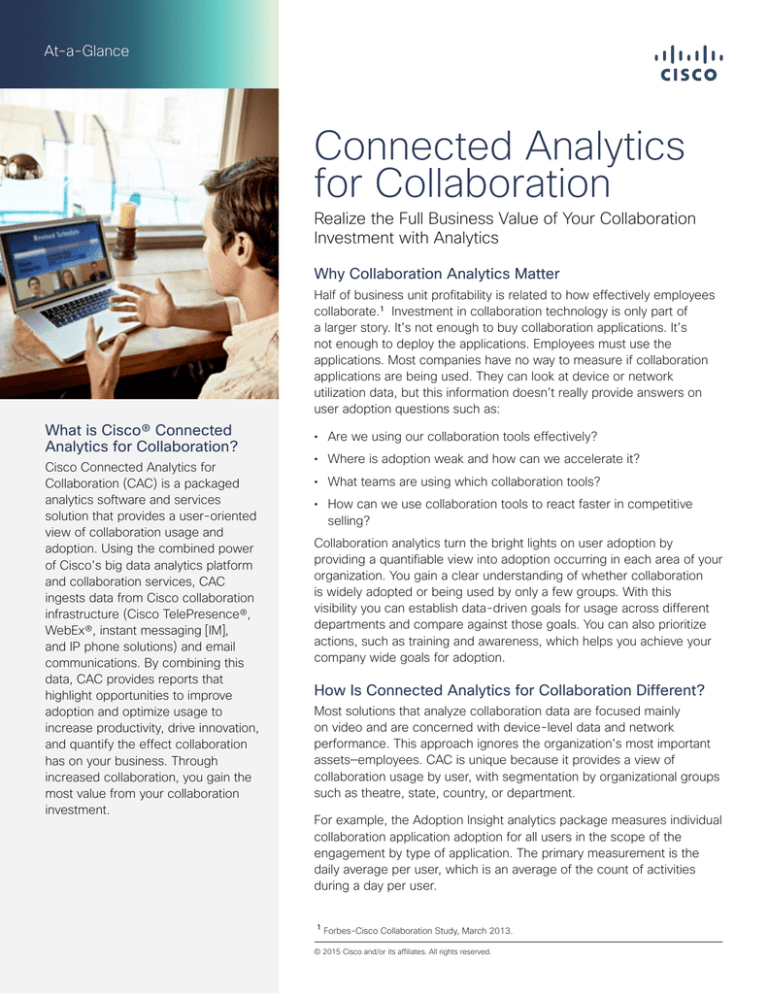
At-a-Glance
Connected Analytics
for Collaboration
Realize the Full Business Value of Your Collaboration
Investment with Analytics
Why Collaboration Analytics Matter
Half of business unit profitability is related to how effectively employees
collaborate.1 Investment in collaboration technology is only part of
a larger story. It’s not enough to buy collaboration applications. It’s
not enough to deploy the applications. Employees must use the
applications. Most companies have no way to measure if collaboration
applications are being used. They can look at device or network
utilization data, but this information doesn’t really provide answers on
user adoption questions such as:
What is Cisco® Connected
Analytics for Collaboration?
Cisco Connected Analytics for
Collaboration (CAC) is a packaged
analytics software and services
solution that provides a user-oriented
view of collaboration usage and
adoption. Using the combined power
of Cisco’s big data analytics platform
and collaboration services, CAC
ingests data from Cisco collaboration
infrastructure (Cisco TelePresence®,
WebEx®, instant messaging [IM],
and IP phone solutions) and email
communications. By combining this
data, CAC provides reports that
highlight opportunities to improve
adoption and optimize usage to
increase productivity, drive innovation,
and quantify the effect collaboration
has on your business. Through
increased collaboration, you gain the
most value from your collaboration
investment.
• Are we using our collaboration tools effectively?
• Where is adoption weak and how can we accelerate it?
• What teams are using which collaboration tools?
• How can we use collaboration tools to react faster in competitive
selling?
Collaboration analytics turn the bright lights on user adoption by
providing a quantifiable view into adoption occurring in each area of your
organization. You gain a clear understanding of whether collaboration
is widely adopted or being used by only a few groups. With this
visibility you can establish data-driven goals for usage across different
departments and compare against those goals. You can also prioritize
actions, such as training and awareness, which helps you achieve your
company wide goals for adoption.
How Is Connected Analytics for Collaboration Different?
Most solutions that analyze collaboration data are focused mainly
on video and are concerned with device-level data and network
performance. This approach ignores the organization’s most important
assets—employees. CAC is unique because it provides a view of
collaboration usage by user, with segmentation by organizational groups
such as theatre, state, country, or department.
For example, the Adoption Insight analytics package measures individual
collaboration application adoption for all users in the scope of the
engagement by type of application. The primary measurement is the
daily average per user, which is an average of the count of activities
during a day per user.
1
Forbes-Cisco Collaboration Study, March 2013.
© 2015 Cisco and/or its affiliates. All rights reserved.
nce
At-a-Glance
Benefits of Connected
Analytics for Collaboration
CAC extends the lifecycle of solutions
for your business. Cisco has solutions
that help you plan and deploy your
collaboration estate. Analytics measure
the net outcome of your investment,
so you know if you are getting the full
value from it.
With CAC, you get automated,
quantifiable information on
collaboration usage across your entire
organization. With this information you
can:
• Set goals for collaboration usage
across the company and promote
continuous improvement toward
your goals
• Make data-driven decisions on
which areas of the company need
training to increase adoption
• Quantify travel-expense reduction
and carbon-footprint reduction
encountered through collaboration
usage
• Achieve the net outcome of
collaboration analytics, ensuring
you achieve your ROI from your
collaboration investments
The Travel Reduction Insight analytics package quantifies the savings
realized through the use of immersive Cisco TelePresence technology.
What are Some Example Use Cases?
Table 1 shows three specific business use cases where CAC can
provide insight for business outcomes:
Table 1. CAC Business Use Cases, Insights, and Outcomes
Use Case
How CAC Provides Insight
Outcome
Increase
Engagement of
Remote Workers
Use adoption insight and
organization segmentation to
see who is, and isn’t, using
video.
Improve participation,
engagement, and
connectedness.
Gain Visibility of
Collaboration
Before, During, and
After a Merger or
Acquisition
See whether your collaboration
is frequent and bidirectional or
one sided and sporadic.
Visibility and ability to
monitor change and create
targeted interventions for
faster group integration.
Before a Large
Collaboration
Initiative
Baseline current collaboration
and discover opportunities
for improvement by analyzing
email, phone, IM, and videoconferencing and webconferencing usage levels.
Gain an understanding of
tool usage and preferences
to determine collaboration
needs.
Why Cisco?
The true value from data and analytics comes from acting on the
insights found when connecting the unconnected. Cisco brings together
data and analytics in a way no other company can. Not only does
Cisco connect more people, processes, data, and things than any
other company, but we also can bring analytics to data wherever it is.
No matter how big or how remote, we can turn information into action
almost instantly. We bring data access and analytics to the edge of the
network to provide information and insight. Use this insight to change
behavior, capture opportunity, respond to threats, and improve your
business.
Next Steps
For more information about Connected Analytics for Collaboration, visit
the Cisco Connected Analytics for Collaboration webpage.
To request a private briefing, contact us at sales-connectedanalytics@
cisco.com.
© 2015 Cisco and/or its affiliates. All rights reserved. Cisco and the Cisco logo are trademarks or registered trademarks of
Cisco and/or its affiliates in the U.S. and other countries. To view a list of Cisco trademarks, go to this URL: www.cisco.com/
go/trademarks. Third-party trademarks mentioned are the property of their respective owners. The use of the word partner
does not imply a partnership relationship between Cisco and any other company. (1110R)
C45-123456-00 04/15



